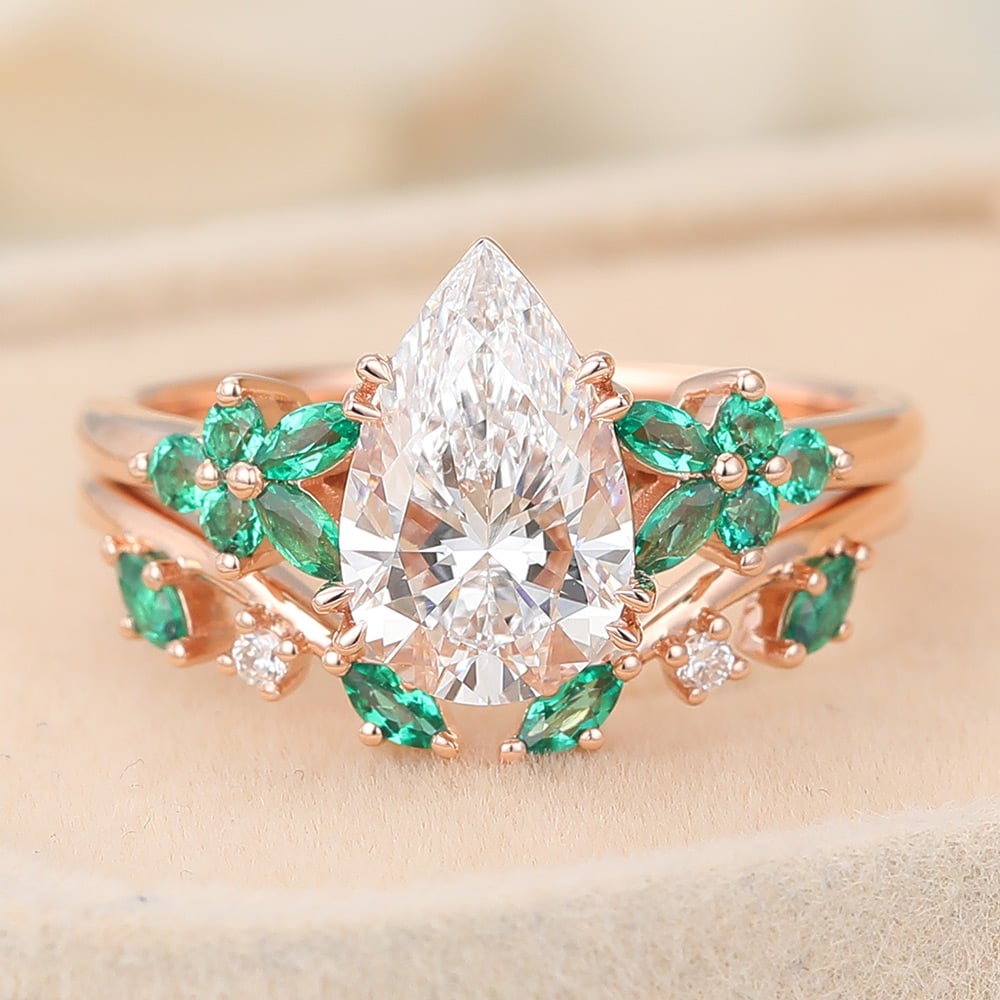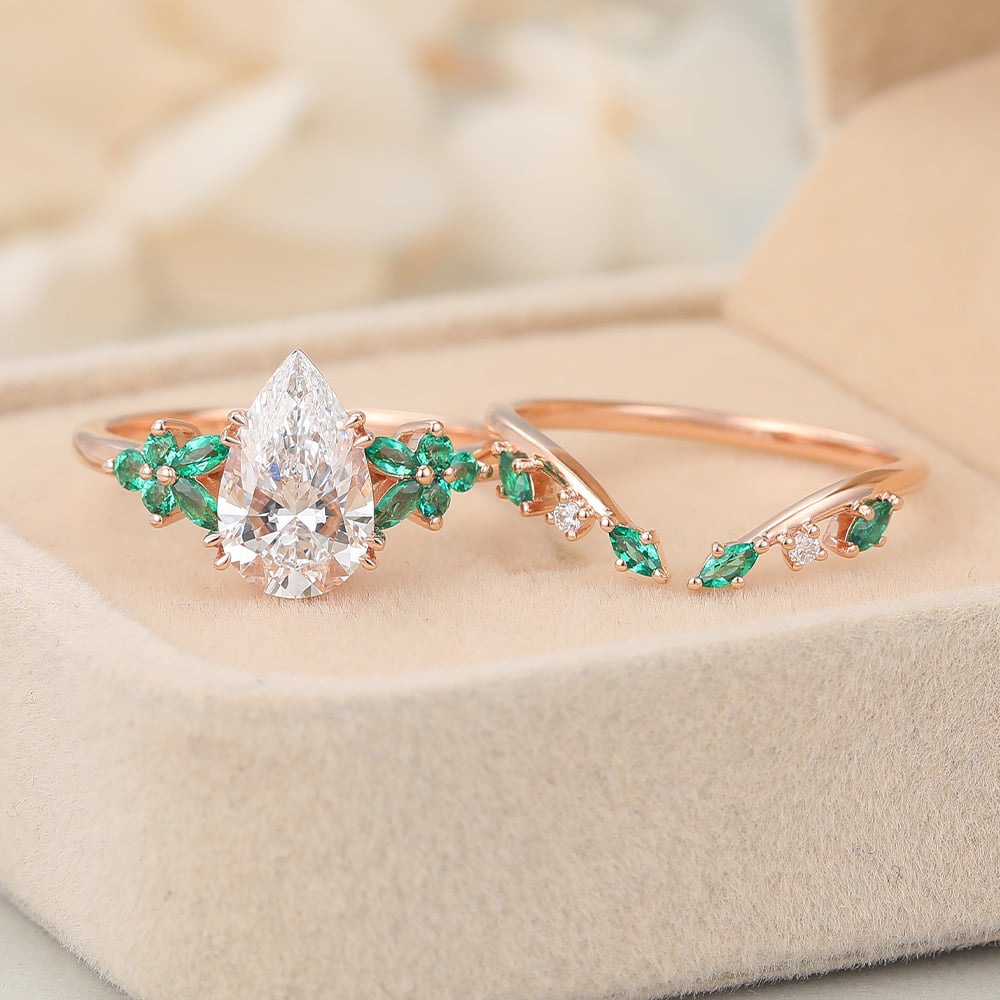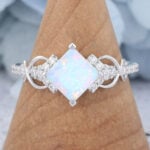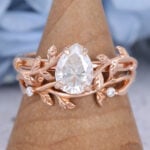Green Sapphire vs Emerald: Key Differences in Color, Value, and Durability
When choosing a green colour stone ring, understanding the differences in Green Sapphire vs Emerald is essential. Both gemstones captivate with their beauty—emeralds offer a rich green hue, while green sapphires are a gem that’s green and blue, blending cool tones with sparkling brilliance. Exploring the unique qualities of each green stone with sparkles helps you find the perfect fit for your style and meaning.
Green Sapphire vs Emerald in Composition
Green Sapphire belongs to the corundum family and is mainly composed of aluminum oxide. The trace elements of iron (Fe) and chromium make the originally colorless corundum become green sapphires with a variety of tones ranging from light green, dark green to bluish green, with a cool color and high transparency.
Emerald composition is a silicate and belongs to the beryl family. The trace amounts of chromium (Cr) and/or vanadium (V) in emerald give emeralds their unique rich and vivid green to bluish green tones, but they are often accompanied by obvious inclusions, which are called “jardin” (garden) and are part of their natural characteristics.
Green Sapphire vs Emerald in Visual Appearance: Color, Clarity, and Sparkle
Natural Green Sapphire is usually cool in color, sometimes even with a hint of gray. Although not as intense and bright as Emerald, it shows a more natural and tranquil beauty. Its crystal structure is dense and has fewer natural inclusions, so it has higher clarity and good transparency. Coupled with the higher refractive index, after fine cutting, green sapphire can show sharp and bright flashes, and the overall visual effect is clean and neat, which is a kind of clear green gemstone.
In contrast, Emerald is known for its high saturation, rich and slightly bluish green, and is the most representative green color gemstone jewelry in the jewelry industry. It usually contains obvious inclusions, called “jardin” (French for “garden”), although the clarity is not high, these inclusions are regarded as one of the unique charms of natural emeralds. Its refractive index is lower than that of sapphire, and the light is softer, but it presents a warm and deep color beauty, which is particularly suitable for retro or elegant jewelry design.
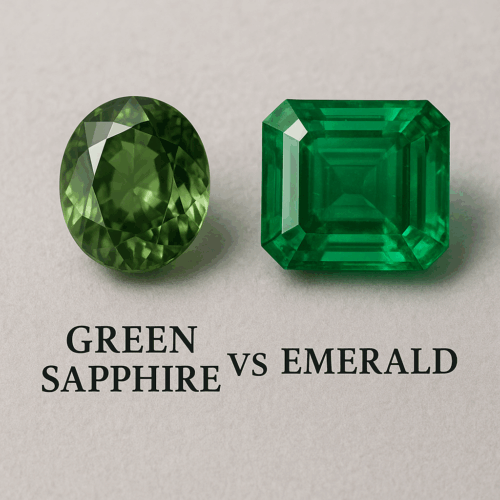
Green Sapphire vs Emerald in Durability
The durability of sapphire is higher than many other gemstones. Green sapphire has a hardness scale of 9, second only to the hardest substance in nature – diamond (10). In addition, green sapphire has a dense structure, few cracks, high toughness, and is not easy to break, making it suitable for frequent daily wear.
Emerald hardness is about 7.5-8, which is also in the higher hardness range. However, emeralds usually contain more natural inclusions and microcracks, which makes them less tough and less impact-resistant, so avoid bumps and collisions when wearing them.
Green Sapphire vs Emerald in Rarity and Sourcing
Green sapphires are relatively rare in the market compared to common blue sapphires. The main sources of green sapphires include Sri Lanka, Madagascar and Australia.
Emerald is the rarest and most sought-after of all green gemstones, especially natural emeralds with rich colors and high clarity, which are extremely scarce in the market. High-quality emeralds often cost more per carat than high-quality diamonds. The main sources of emeralds are Colombia and Zambia.
Green Sapphire vs Emerald in Value and Pricing
Natural green sapphires are relatively rare in the colored sapphire series and have a stable market value. Natural green sapphires range from a few hundred to two or three thousand dollars per carat, and the top-grade unheated, pure-color varieties green sapphire costs more. Lab green sapphires are more affordable because of their stable production, usually 1/3-1/5 lower than natural products, and are suitable for consumers who pursue practicality and environmental protection.
Emerald is one of the most precious and representative green gemstones in the world, with extremely high appreciation potential. The value of medium-quality emeralds is about $1,000-5,000 per carat; high-quality emeralds can even exceed $10,000 per carat. The market acceptance of laboratory emeralds is also increasing year by year, and the price per carat is usually around a few hundred dollars.
Green Sapphire vs Emerald in Symbolism and Meaning
The meaning of green sapphire is rooted in balance, wisdom, and focus. It symbolizes inner peace, loyalty, and emotional clarity, making it a perfect stone for those who seek calm, truth, and self-control in relationships and life decisions.
The meaning of emerald is deeply connected to love, rebirth, and heart-centered energy. It represents emotional depth, healing, and compassion. Often linked to romantic devotion, emerald inspires passion and encourages openness and understanding in relationships.
Green Sapphire vs Emerald in Ideal Uses in Jewelry
Emerald and sapphire jewelry, including rings, earrings, and pendants, blends brilliance with symbolic depth. Emerald and sapphire rings stand out for their timeless charm. The meaning of emerald and sapphire engagement and wedding rings reflects loyalty, renewal, and emotional harmony.
Green Sapphire and Emerald vs Other Green or Blue Gemstones
Green Tourmaline vs Emerald
Green tourmaline is brighter and more affordable than emerald, with fewer inclusions. While emerald has deeper color and higher prestige, it’s more fragile and costly.
Peridot vs Emerald
Peridot has a yellow-green hue and is softer than emerald. Emerald offers richer color and symbolic depth, making it more desirable for fine jewelry.
Jade vs Emerald
Jade is smooth and opaque, valued for cultural and spiritual meaning. Emerald, by contrast, is transparent, vivid, and prized for brilliance and rarity.
Tsavorite vs Emerald
Tsavorite is a vivid green garnet with excellent clarity and brilliance. It rivals emerald in beauty but is more durable and often more budget-friendly.
Tanzanite vs Sapphire
Tanzanite is prized for its striking blue-violet hues and rarity, found only in Tanzania. While sapphires are harder and more durable, sapphires offer a broader color range, including green and blue. Tanzanite’s unique color shift makes it a distinctive choice, but sapphire remains a classic for everyday wear.
Conclusion
Green sapphire and emerald differ in color tone, value, and durability. While emerald offers rich tradition and romance, green sapphire provides clarity, strength, and subtle elegance—making each ideal for different personal styles and jewelry needs.
.
FAQs About Green Sapphire vs Emerald
Are rubies, emeralds or sapphires more expensive?
Among rubies, emeralds, and sapphires, rubies are often the most expensive per carat, especially in high quality, but emeralds can be pricier than sapphires due to rarity.
What is a green gem? Are emeralds green?
A green gem is a stone that appears green in color. Emeralds are green and among the most prized green gemstones. Green gemstones are called emeralds, jade, peridot, and green sapphire.
Kelly green vs hunter green vs dark green vs forest green vs emerald green — among these different emerald colors, which one is considered the most ideal for a real emerald?
Among these different emerald colors, emerald green is considered the most ideal for a real emerald because of its deep, vivid tone and perfect balance of blue and green.
Are emeralds sapphires? Are sapphires durable? Are green sapphires rare?
Emeralds are not sapphires; they are different gemstones. Sapphires are very durable because sapphires are hard, rating 9 on the Mohs scale. Green sapphires are rarer than blue sapphires but still more common than emeralds.
How hard are emeralds? Is emerald expensive than diamond? Can emeralds be different colors?
Emeralds are 7.5–8 on the Mohs scale. High-quality emeralds can be more expensive than diamonds per carat. While typically green, emeralds do not come in other colors—other colors of beryl have different names.

